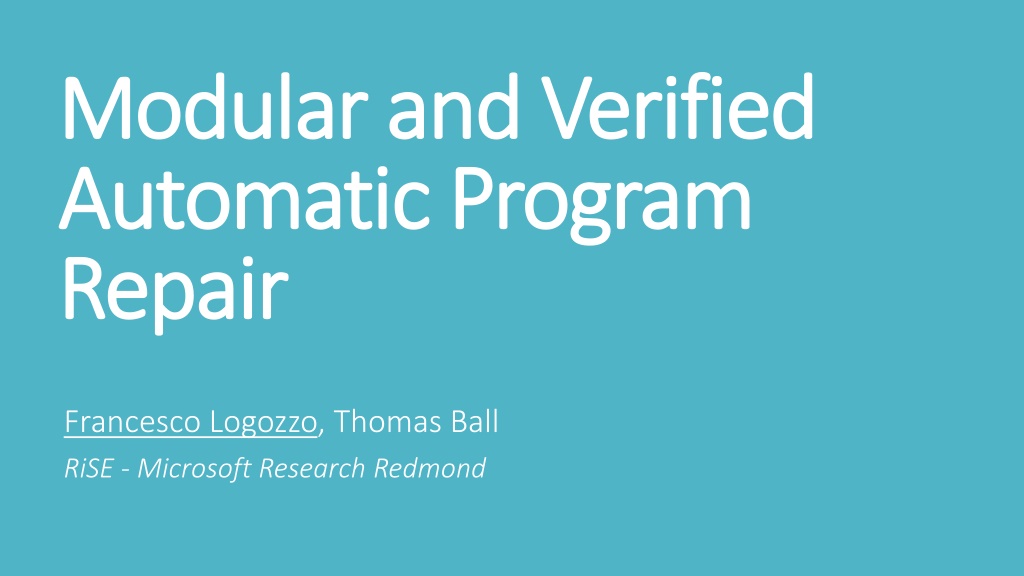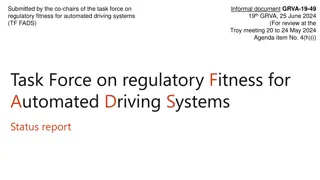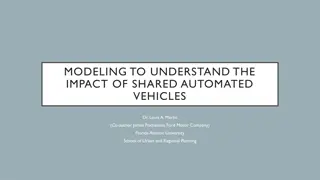Advancing Automated Program Repair Through Verified Code Modifications
Explore the evolution of automated program repair, focusing on enhancing bug detection with actionable fixes reported by static analyzers. Discover the concept of verified code repairs, ensuring repaired programs maintain good behavior without compromising existing functionalities.
Download Presentation

Please find below an Image/Link to download the presentation.
The content on the website is provided AS IS for your information and personal use only. It may not be sold, licensed, or shared on other websites without obtaining consent from the author. Download presentation by click this link. If you encounter any issues during the download, it is possible that the publisher has removed the file from their server.
E N D
Presentation Transcript
Modular and Verified Modular and Verified Automatic Program Automatic Program Repair Repair Francesco Logozzo, Thomas Ball RiSE - Microsoft Research Redmond
The problem Programs have bugs Bug finders, static analyzers and verifiers, etc. help spot them However, they provide little or no help for fixing the bugs The goal Bring static analyses to the next level Report both the warning and the fix for it While the programmer is authoring the program
Which bugs? We focus on possible bugs reported by static analyzers/verifiers Motto: We can only fix what we can prove correct We can only fix what we can prove correct For instance, the CodeContracts static checker (Clousot) reports Contract violations Common runtime errors: Null pointers, division by zero, arithmetic overflows We should not only report the warning, but also a set of fixes for it Increase adoption Overcome the scaring long list of warnings Help understanding the origin of the warning Code is clearer than an error trace
What is a code repair? In testing, use the test suite T as a specification The buggy program fails at least one test in T The repaired program succeeds all the tests in T The repaired program is obtained by some mutation of the buggy program This definition is unsuited for real-time program verification It requires running the program At design time, the program is incomplete, does not compile Test running can be expensive The repair is as good as the test suite T Example: fix assert(e) with if(e) assert(e)
Verified code repairs We propose a different yet semantic notion of repairs A verified repair reduces the bad runs while increasing the good runs A good run is one that satisfies the specification Assertion, precondition, runtime condition A bad run is one that violates the specification Consequences: When we repair a program we cannot remove any good behavior There can be multiple, non comparable, repairs No best repair in general!
Example Example
From the .NET library public void ValidateOwnerDrawRegions(ComboBox c, Rectangle updateRegionBox) { if (c == null) { var r = new Rectangle(0, 0, c.Width, c.Height); // } }
Repair #1: change the guard public void ValidateOwnerDrawRegions(ComboBox c, Rectangle updateRegionBox) { if (c != null) { var r = new Rectangle(0, 0, c.Width, c.Height); // } }
Repair #2: Add precondition public void ValidateOwnerDrawRegions(ComboBox c, Rectangle updateRegionBox) { Contract.Requires(c != null); if (c == null) { var r = new Rectangle(0, 0, c.Width, c.Height); // } }
What if the code was like that? public void ValidateOwnerDrawRegions(ComboBox c, Rectangle updateRegionBox) { if (c == null) { var r = new Rectangle(0, 0, c.Width, c.Height); // } else { var area = c.Width * c.Height; // } }
Changing the guard removes good runs public void ValidateOwnerDrawRegions(ComboBox c, Rectangle updateRegionBox) { if (c != null) { var r = new Rectangle(0, 0, c.Width, c.Height); // } else { var area = c.Width * c.Height; // } } This is not a verified repair!
Adding a precondition removes bad runs public void ValidateOwnerDrawRegions(ComboBox c, Rectangle updateRegionBox) { Contract.Requires(c != null); if (c == null) { var r = new Rectangle(0, 0, c.Width, c.Height); // } else { var area = c.Width * c.Height; // } This is a verified repair! }
Program analysis and Code repairs There are three components in program analysis The program text The specification, the property to be specified The analysis result, the semantic knowledge about the program execution The (usual) verification problem is Check that the analysis result guarantees that the program meets its specification" The (new) verified code repair problem is Refine the program using the analysis result so that it meets its specification Related, but different than program synthesis
Repairs are property-dependent In static analysis tools, the knowledge is given by the inferred abstract state Similar for tools based on model checking, deductive methods, types The abstract state belongs to some abstract domain The abstract domain encodes some property of interest Idea: An abstract domain should also know how to repair the program Therefore the verified code repairs depend are property-dependent E.g., often we cannot repair non-functional bugs like performance
Some definitions A run is an execution trace, i.e., a sequence of concrete states For all programs P, we partition the set of runs into G(P), the good runs B(P), the bad runs We do not consider infinite traces here Technically possible, complicates the exposition A repair r is a program transformation with some correctness condition Next: define the correctness condition
Verified repairs? We may be tempted to define a verified repair as G(P) G(r(P)) and B(P) B(r(P)) But this definition is too strong! It would work only for trivial repairs Execution traces capture too much information They are too fine grained, the repair may add new assertions Solution? Perform abstractions! The abstraction captures the behaviors we want to preserve and to correct Intuition: Repair up to some observable property
Verified code repairs! Idea: compare only the assertion runs of P and r(P) Forget about intermediate states, keep only the states with the assertions Define an abstraction function V in two steps 1. Remove all the states but those containing an assertion 2. Remove all assertions in r(P) but not in P We want to compare only the old assertions Definition: r is a verified code repair verified code repair if V (G(P)) V (G(r(P))) and V (B(P)) V (B(r(P)))
Consequences Identity is not a repair Runs of failing assertions should always decrease For a given program there may be several distinct repairs r1,r2,r3 The relation induces an order on programs P r1(P) r1(r2(P)) Repairs can be iterated to a fixpoint In general there is no least fixpoint No diamond property
Weak verified repairs Further abstraction W to Have sets of states instead of sets of traces Forget the casual relationship between states Have assertion truth instead of the particular values of the variables Definition: r is a weak verified repair weak verified repair if W V (G(P)) W V (G(r(P))) and W V (B(P)) W V (B(r(P))) Intuition: a weak verified repair Decreases the number of assertion violations without introducing regressions Enables more repairs but with weaker guarantees in the concrete
Methodology Design an abstract domain as usual Abstract elements, domain operations, widening, transfer functions Design a code repair for the properties captured by the new abstract domain Remember, code repairs are property-specific Categorize your code repair: Strong or weak verified repair?
Verified repairs from a static analyzer Run the static analyzer to infer the abstract states For each assertion in the program Ask the abstract domains if they can prove it If they cannot, ask the abstract domains to provide a code repair Providing a code repair may require re-running the analysis To check that there are no new warnings
Repairing floats double f; void SimpleError(double a, double b) { var tmp = a + b; this.f = tmp; if (this.f == tmp) { } } fext f32 f64 Clousot infers this.f : f64 tmp : fext Emits warning for precision mismatch Suggests the verified repair: tmp = (double)(a + b)
Repairing of overflows int BinarySearch(int[] array, int value) { Contract.Requires(array != null); Clousot infers the loop invariant 0 inf sup < array.Length 231-1 int index, mid; var inf = 0; var sup = array.Length - 1; We want to repair the arithmetic overflow Suggest the verified repair: while (inf <= sup) { index = (inf + sup) / 2; inf + (sup inf)/2 Guaranteed to not overflow Because of the inferred loop invariant mid = array[index]; if (value == mid) return index; if (mid < value) inf = index + 1; else sup = index - 1; } Details in the paper return -1; }
Example of a common error Assume: 0 x, 0 y, 0 z Then x + y < z x + y < z may overflow Exactly, x + y < z in computer precision does not have the same meaning than in We derive a non-overflowing expression like that (x! + y!)? < z! as 0 x, then x cannot underflow = y! < (z! +( x!)!)? as 0 z and 0 x, then z x cannot underflow = y! < (z! +( x!)!)!
Verified repairs in Clousot Contracts Missing preconditions, postconditions, external assumptions, purity annotations Constant and object initialization Guards Buffer overflows Arithmetic overflows Floating point comparisons Details in the paper
Implementation Clousot is the underlying static analyzer Part of the CodeContracts tools, widely used More than 75K external downloads Based on abstract interpretation Analyze each method in isolation Infer loop invariants, preconditions, postconditions, and object invariants Use the inferred facts to discharge proof obligations On failure suggest a verified code repair Runs at design time Came to see the demo!
Raw numbers Analyze .NET main libraries Check Contracts, non-null, overflows Analyze 6+ methods/seconds Infer 7.5 repairs/second
Precision Don t know 11% Verified 89% Verified repairs 9% Warnings 2%
Conclusions Bring static analysis to the next level Simple flood of warnings is not practical Suggest verified and modular repairs Verified repairs increase the good executions while reducing the bad ones Up to some observable property Verified repairs are property dependent Implemented on a real static analyzer Get a repair for 80.9% of the warnings Come to see the demo in a couple of minutes!!!!























